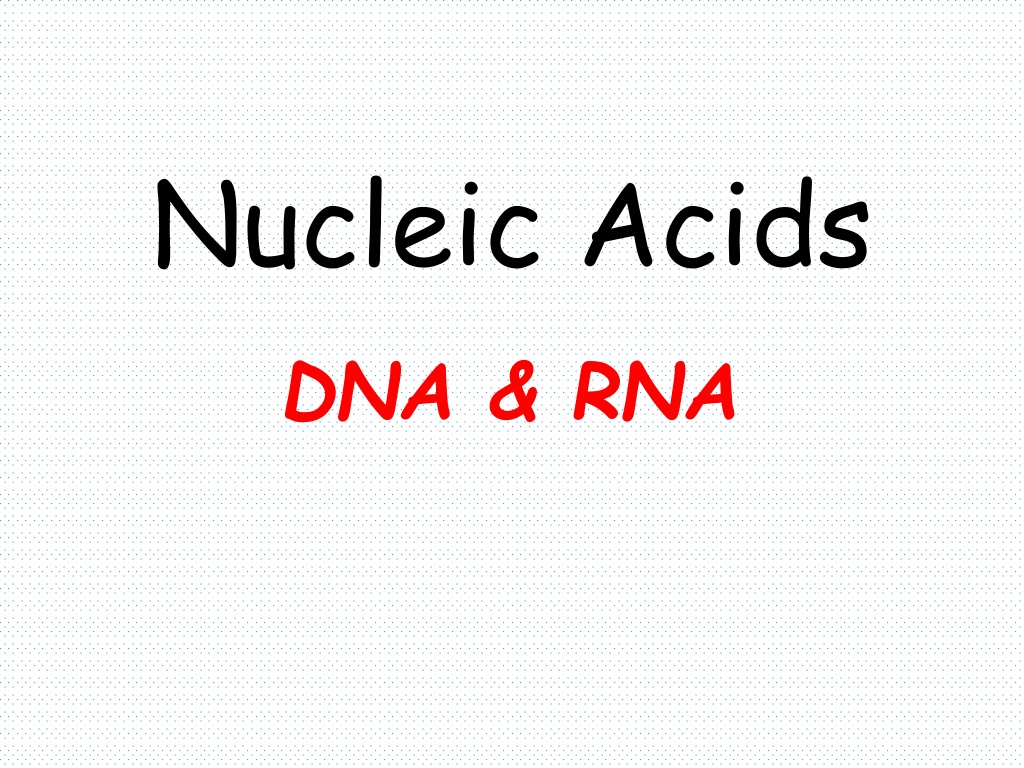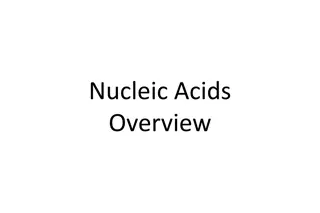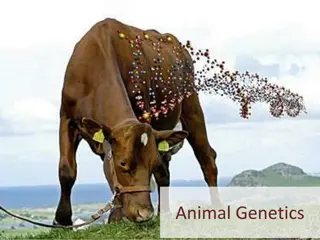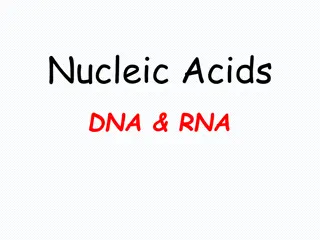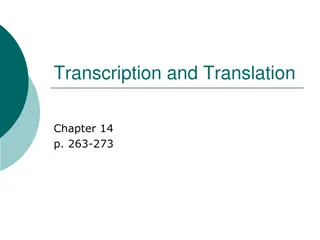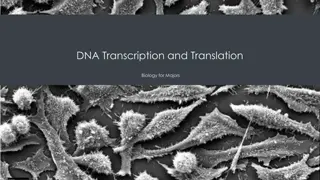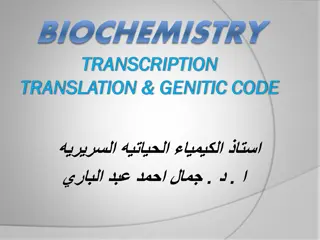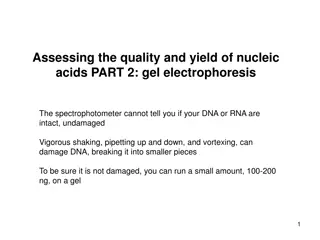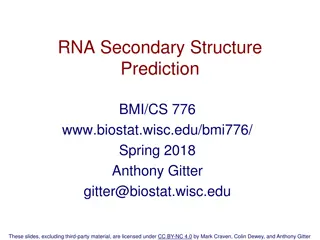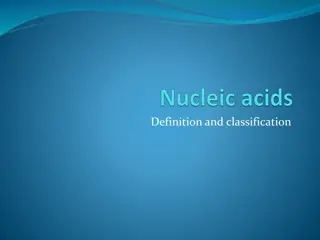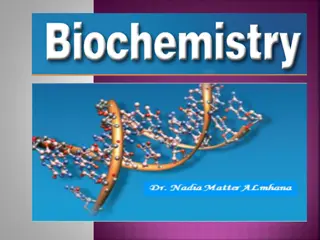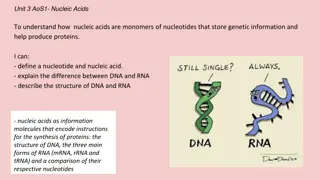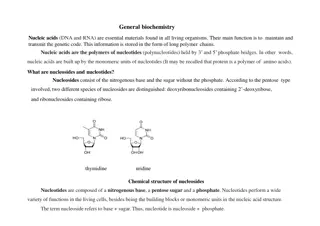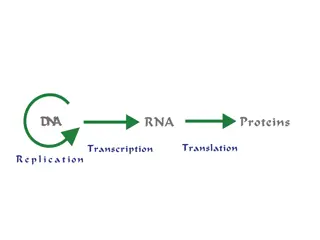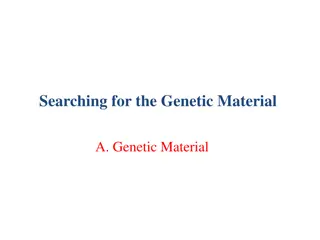Nucleic Acids: DNA and RNA Structure and Function
Delve into the world of nucleic acids with a focus on DNA and RNA molecules. Discover the fundamental building blocks, such as nucleotides, and the role they play in genetic information storage and cell function. Learn about the unique characteristics of DNA like its double-helix structure and the significance of base pairing. Uncover the differences between DNA and RNA, their nucleotide components, and the impact of heterocycles in these critical biomolecules.
Download Presentation

Please find below an Image/Link to download the presentation.
The content on the website is provided AS IS for your information and personal use only. It may not be sold, licensed, or shared on other websites without obtaining consent from the author.If you encounter any issues during the download, it is possible that the publisher has removed the file from their server.
You are allowed to download the files provided on this website for personal or commercial use, subject to the condition that they are used lawfully. All files are the property of their respective owners.
The content on the website is provided AS IS for your information and personal use only. It may not be sold, licensed, or shared on other websites without obtaining consent from the author.
E N D
Presentation Transcript
Nucleic Acids DNA & RNA
Watson Crick Died in 2004
DNA DNA stands for deoxyribose nucleic acid This chemical substance is present in the nucleus of all cells in all living organisms DNA controls all the chemical changes which take place in cells The kind of cell which is formed, (muscle, blood, nerve etc) is controlled by DNA
DNA molecule DNA is a very large molecule made up of a long chain of sub-units The sub-units are called nucleotides Each nucleotide is made up of a sugar called deoxyribose a phosphate group -PO4 and an organic base
Nucleic Acids and Nucleotides Deoxyribonucleic acid (DNA) and ribonucleic acid (RNA), are the chemical carriers of genetic information Nucleic acids are biopolymers made of nucleotides, aldopentoses linked to a purine or pyrimidine and a phosphate
Heterocycles in DNA and RNA Adenine, guanine, cytosine and thymine are in DNA RNA contains uracil rather than thymine
Deoxyribonucleotides found in DNA dT dC dG dA
Hydrogen Bonding Interactions Two bases can hydrogen bond to form a base pair For monomers, large number of base pairs is possible In polynucleotide, only few possibilities exist Watson-Crick base pairs predominate in double- stranded DNA A pairs with T C pairs with G Purine pairs with pyrimidine
the building block molecule of nucleic acid--nucleotide In RNA: AMP CMP GMP TMP In DNA: dAMP dCMP dGMP dUMP
Functions of Nucleotides and Nucleic Acids Nucleotide Functions: Energy for metabolism (ATP) Enzyme cofactors (NAD+) Signal transduction (cAMP) Nucleic Acid Functions: Storage of genetic info (DNA) Transmission of genetic info (mRNA) Processing of genetic information (ribozymes) Protein synthesis (tRNA and rRNA)
the linkage ---- phosphodiester bridge 3 terminal 5 terminal Nucleotide residues
DNA Nucleotides Composition (3 parts): 1- Deoxyribose sugar (no O in 3rd carbon) 2- Phosphate group 3- One of 4 types of bases (all containing nitrogen): - Adenine - Thymine (Only in DNA) - Cytosine - Guanine
Base Pairing in DNA: The WatsonCrick Model In 1953 Watson and Crick noted that DNA consists of two polynucleotide strands, running in opposite directions and coiled around each other in a double helix Strands are held together by hydrogen bonds between specific pairs of bases Adenine (A) and thymine (T) form strong hydrogen bonds to each other but not to C or G (G) and cytosine (C) form strong hydrogen bonds to each other but not to A or T
The Difference in the Strands The strands of DNA are complementary because of H- bonding Whenever a G occurs in one strand, a C occurs opposite it in the other strand When an A occurs in one strand, a T occurs in the other
Primary Structure of Nucleic Acids The primary structure of a nucleic acid is the nucleotide sequence The nucleotides in nucleic acids are joined by phosphodiester bonds The 3 -OH group of the sugar in one nucleotide forms an ester bond to the phosphate group on the 5 -carbon of the sugar of the next nucleotide
Reading Primary Structure A nucleic acid polymer has a free 5 - phosphate group at one end and a free 3 -OH group at the other end The sequence is read from the free 5 -end using the letters of the bases This example reads 5 A C G T 3
Example of DNA Primary Structure In DNA, A, C, G, and T are linked by 3 -5 ester bonds between deoxyribose and phosphate
Nucleic Acid Structure Polymerization Nucleotide Sugar Phosphate backbone
Describing a Sequence Chain is described from 5 end, identifying the bases in order of occurrence, using the abbreviations A for adenosine, G for guanosine, C for cytidine, and T for thymine (or U for uracil in RNA) A typical sequence is written as TAGGCT
Properties of a DNA double helix The strands of DNA are antiparallel The strands are complimentary There are Hydrogen bond forces There are base stacking interactions There are 10 base pairs per turn
